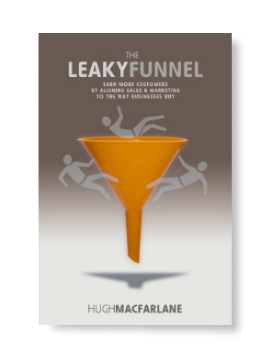Managing and monitoring your sales pipeline is key to the achievement of your stretching sales targets.
The good news is that Hugh Macfarlane’s book – “The Leaky Funnel” – provides a fantastic and easily accessible overview of why this process is so important. Ready?
10 second summary
This book presents ideas for managing the “leaky funnel” – and argues that sales success can be achieved when businesses map their pipeline, identify hotspots for fallout, plug the leaks and quickly “recycle” and incubate prospects who don’t initially convert.
Key reason you should read the Leaky Funnel
This excellent sales book is written as a business novel – as a result, it’s a highly accessible read that’s packed with sound business principles. It follows Sue Hunt’s journey as the new CEO at HardBits (a fictional company and a leading supplier of plastic beads). Sue has been hired because of her ability to “think like a customer”, with the hope that this new approach will be able to turn around HardBits’ performance and remove the barriers that are preventing the company from finding new customers.
HardBits has been struggling in a commoditised market. Declining prices and the challenge to differentiate, means HardBits is looking for a new approach – and the board hopes Sue can identify the solution.
The book takes a detailed look at pipeline management and, through Sue’s journey, reveals how a firm understanding of the sales pipeline can be the start of real change within a business.
 Rapid fire overview of key sales lessons discussed
Rapid fire overview of key sales lessons discussed
Below, I’ve summarised four important lessons that I took from the book:
#1: Customer-Centric Selling
The key argument contained within this book is that businesses should manage their sales pipeline from a customer-centric position.
This means you need to develop a sound understanding of the buyers’ journey as well as be able to identify and understand your customers’ pain so you can position your company’s offer as a solution.
And given the change in consumer behaviour, this totally makes sense. Consumer buying patterns have shifted as a result of the availability of information online – and social search has made it easier than ever to get independent referrals and reviews. As a result, prospects are often extremely well informed BEFORE they get in touch.
Plus, because you can’t tell a customer when it’s the right time to buy, it’s crucial a clear understanding of the journey, context and decision-making process of a typical prospect shapes your sales methods.
#2: Sales and Marketing Unite!
Macfarlane also argues for greater integration between marketing and sales to ensure these essential business functions are more sensitive to the way customers buy.
In particular, he suggests marketing should focus on attracting more highly qualified leads for sales teams to follow up and nurture. In turn, this will translate into increased performance because salespeople are not wasting their time talking to unqualified leads, with no interest in, or need for, the products and services you sell.
#3: Map Out and Measure Your Sales Pipeline
Successful selling requires a carefully mapped pipeline that takes into account the buyers’ journey.
In addition, that pipeline needs to be manageable and measurable. That’s because once you can analyse the effectiveness of your sales process, you’re then able to predict future outcomes, and implement improvements to enhance your results.
Our [sales] tactics, even our strategies, must be about causing progression one step at a time, We choose our tactics and strategies based on how well they contribute to the journey.
#4: Identify and Manage “Leakage”
A key benefit of measuring and monitoring your pipeline is, you’re able to identify where prospects leave your sale pipeline (leak). In turn, you can then implement strategies to reduce the leakage AND recycle prospects. In turn, this should lead to higher conversion rates.
“The money is in how we deal with the 95. How quickly can we catch them when they lead, incubate them and recycle them back into the funnel as fast as we can?”
Suggestions as to How You Can Apply these Insights to Your Pipeline Management
Hopefully, this book will motivate you to review your sales pipeline and assess the tools and techniques you currently rely on, to map out and monitor what happens during your customers’ journey from enquiry to close.
If you’re not already using a CRM system, it’s well worth exploring the various options available on the market. Smart cloud CRMs such as Pipeliner will provide you with a real-time overview of what’s happening in your pipeline. In turn, you can see where the opportunities within your pipeline lie. Plus, with sound measurement processes in place, you can use your CRM to help assess whether or not you’re likely to achieve your targets. And if not, you can intervene and implement a fix – before it’s too late.
Get your free trial of Pipeliner CRM now.
How do you manage your sales pipeline? What tools do you rely on? Please share your thoughts and ideas in the comments below.











